Abstract
The crystal structure of Fab R19.9, derived from an anti-p-azobenzenearsonate monoclonal antibody, has been determined and refined to 2.8-A resolution by x-ray crystallographic techniques. Monoclonal antibody R19.9 (IgG2b kappa) shares some idiotopes with a major idiotype (CRIA) associated with A/J anti-p-azobenzenearsonate antibodies. The amino acid sequences of the variable (V) parts of the heavy (VH) and light (VL) polypeptide chains of monoclonal antibody R19.9 were determined through nucleotide sequencing of their mRNAs. The VL region is very similar to that of CRIA-positive anti-p-azobenzenearsonate antibodies as is VH, except for its third complementarity-determining region, which is three amino acids longer; it makes a loop, unique to R19.9, that protrudes into the solvent. A large number of tyrosine residues in the complementarity-determining region of VH and VL, with their side chains pointing towards the solvent, may have an important function in antigen binding.
Full text
PDF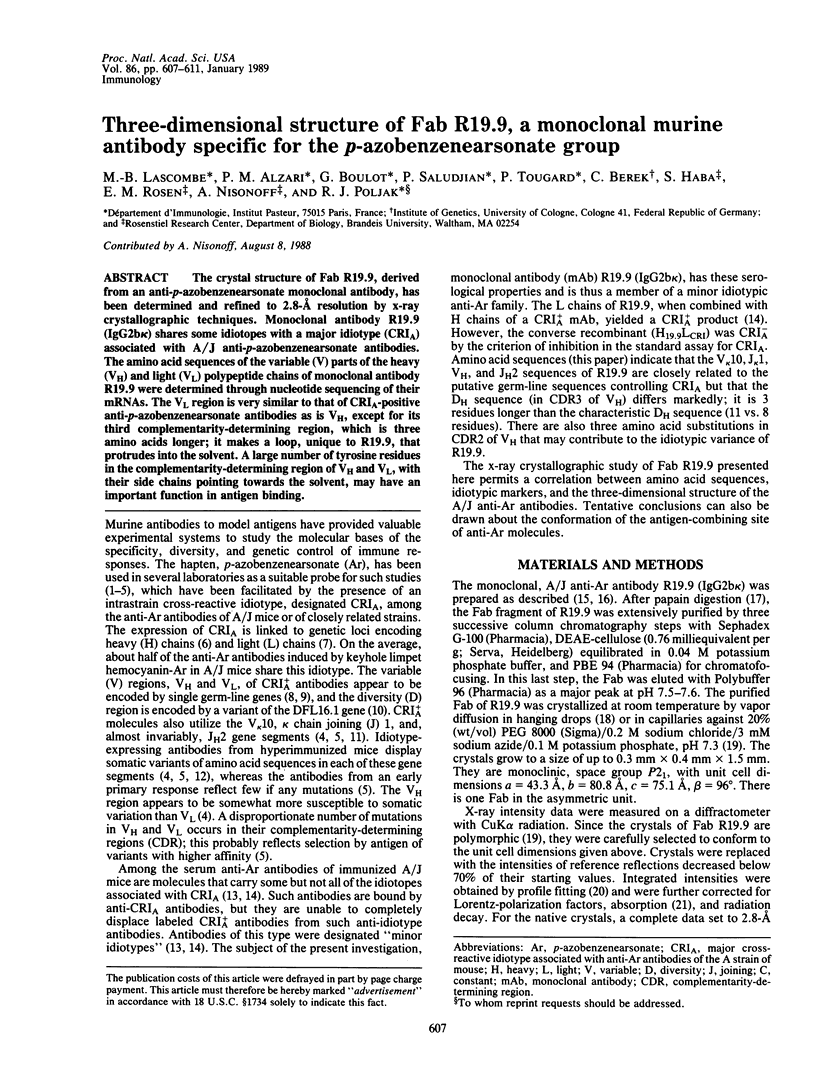
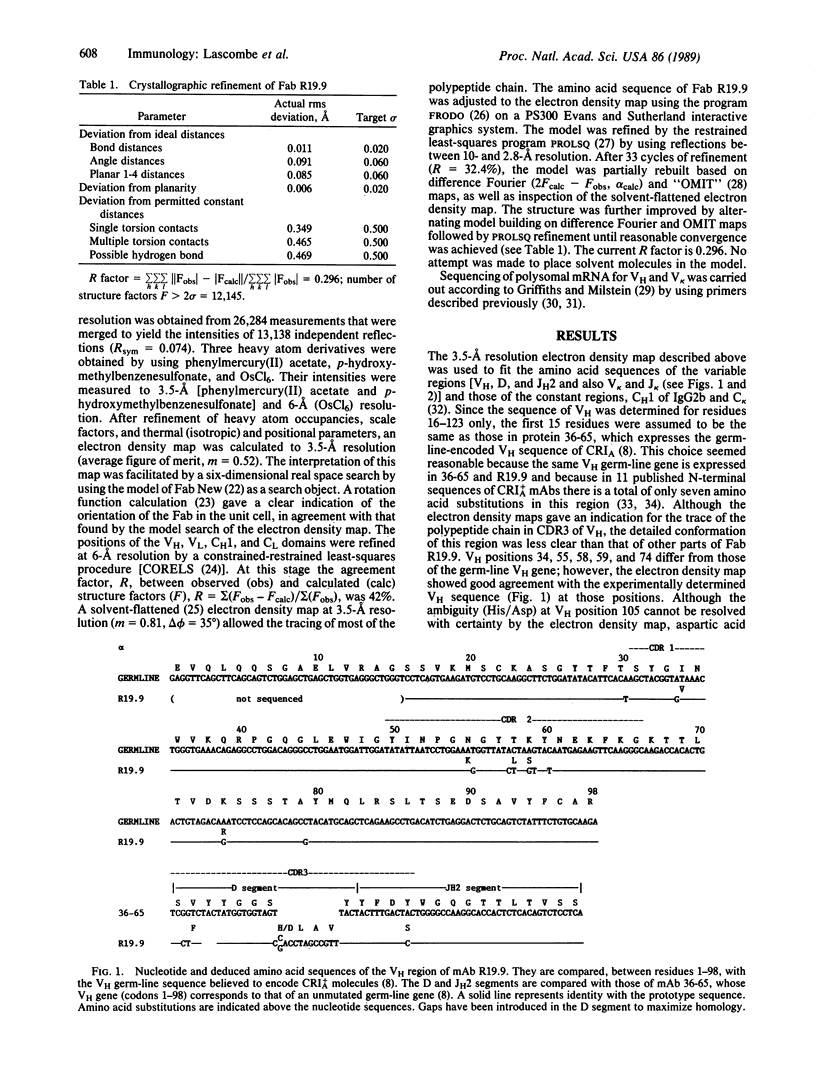
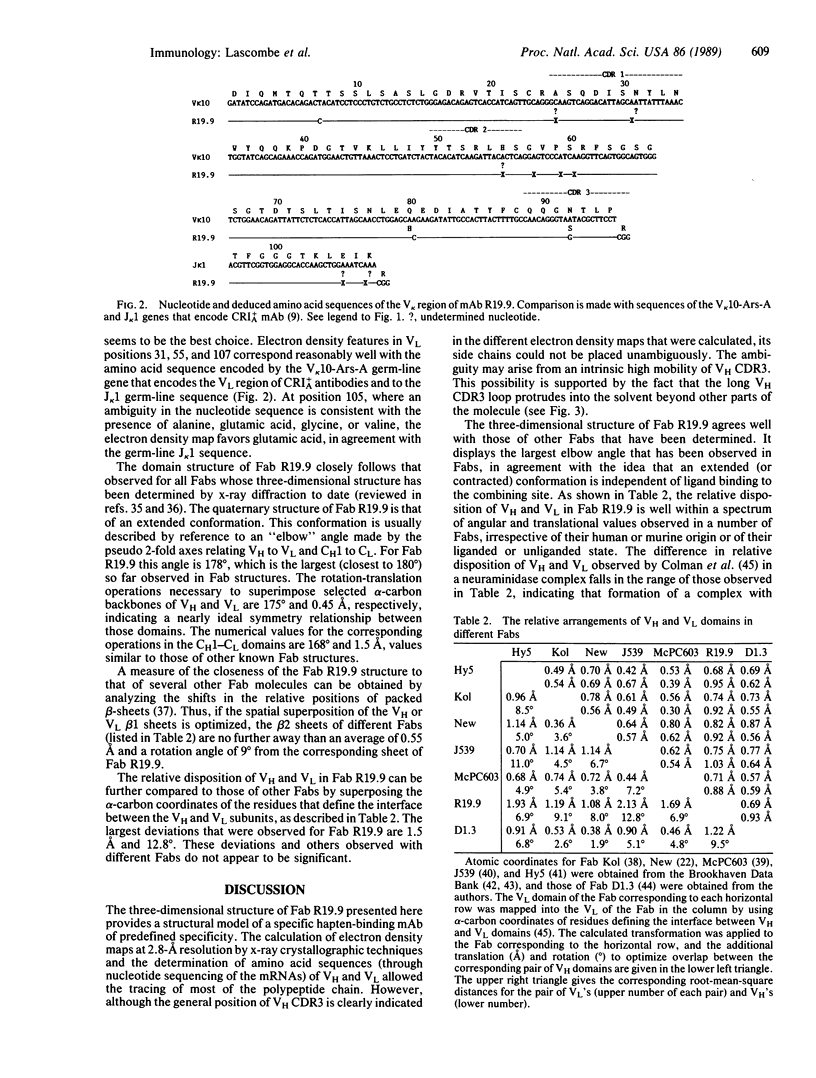
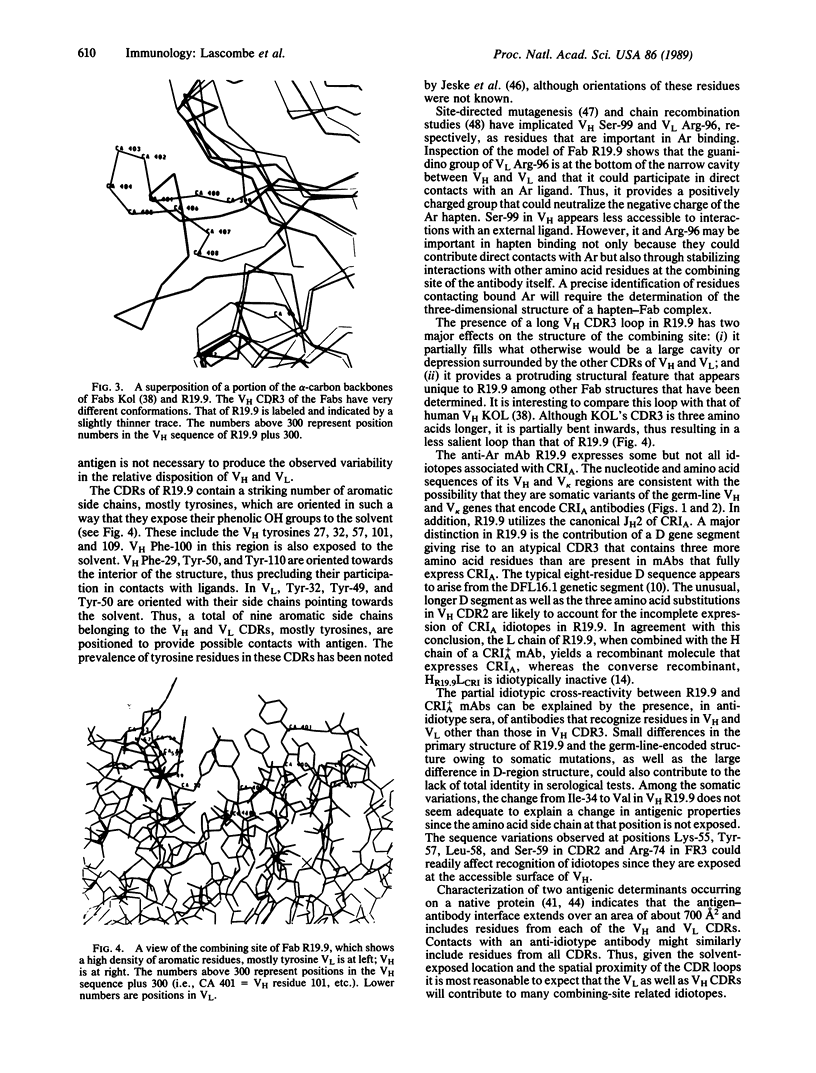
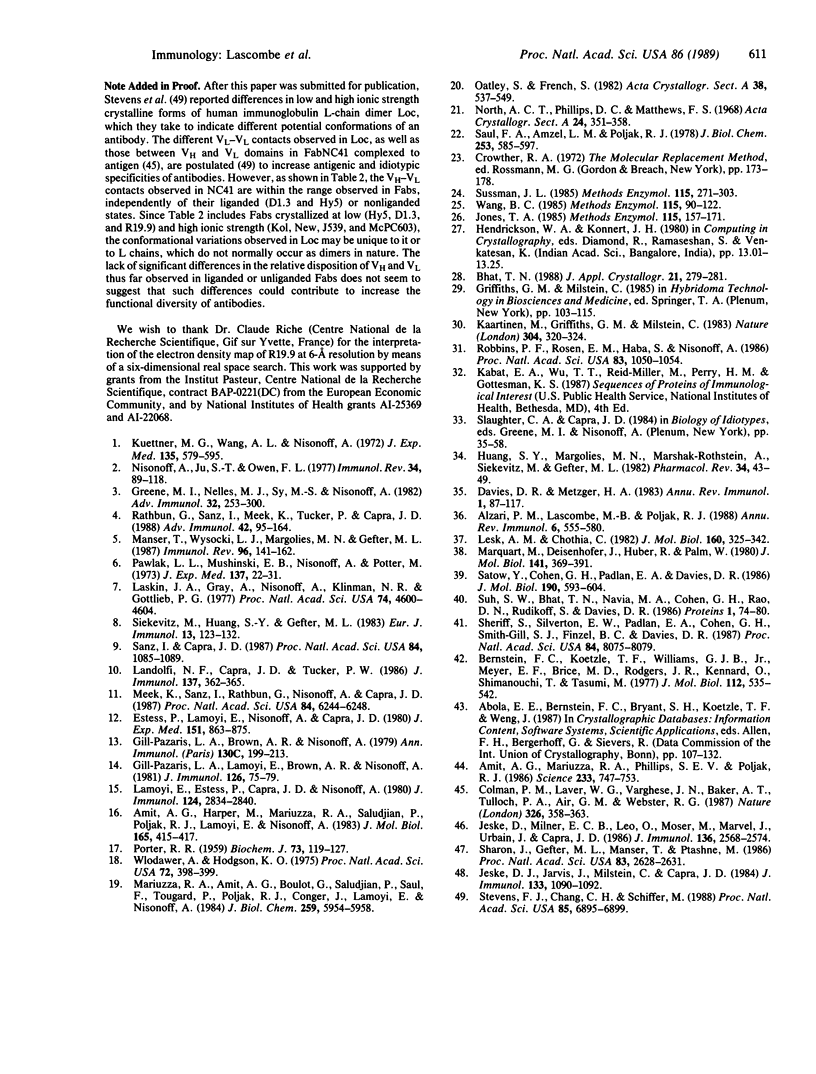
Selected References
These references are in PubMed. This may not be the complete list of references from this article.
- Alzari P. M., Lascombe M. B., Poljak R. J. Three-dimensional structure of antibodies. Annu Rev Immunol. 1988;6:555–580. doi: 10.1146/annurev.iy.06.040188.003011. [DOI] [PubMed] [Google Scholar]
- Amit A. G., Harper M. M., Mariuzza R. A., Saludjian P., Poljak R. J., Lamoyi E., Nisonoff A. Preliminary crystallographic study of the Fab fragment of a monoclonal anti-phenylarsonate antibody. J Mol Biol. 1983 Apr 5;165(2):415–417. doi: 10.1016/s0022-2836(83)80266-6. [DOI] [PubMed] [Google Scholar]
- Amit A. G., Mariuzza R. A., Phillips S. E., Poljak R. J. Three-dimensional structure of an antigen-antibody complex at 2.8 A resolution. Science. 1986 Aug 15;233(4765):747–753. doi: 10.1126/science.2426778. [DOI] [PubMed] [Google Scholar]
- Bernstein F. C., Koetzle T. F., Williams G. J., Meyer E. F., Jr, Brice M. D., Rodgers J. R., Kennard O., Shimanouchi T., Tasumi M. The Protein Data Bank: a computer-based archival file for macromolecular structures. J Mol Biol. 1977 May 25;112(3):535–542. doi: 10.1016/s0022-2836(77)80200-3. [DOI] [PubMed] [Google Scholar]
- Colman P. M., Laver W. G., Varghese J. N., Baker A. T., Tulloch P. A., Air G. M., Webster R. G. Three-dimensional structure of a complex of antibody with influenza virus neuraminidase. 1987 Mar 26-Apr 1Nature. 326(6111):358–363. doi: 10.1038/326358a0. [DOI] [PubMed] [Google Scholar]
- Davies D. R., Metzger H. Structural basis of antibody function. Annu Rev Immunol. 1983;1:87–117. doi: 10.1146/annurev.iy.01.040183.000511. [DOI] [PubMed] [Google Scholar]
- Estess P., Lamoyi E., Nisonoff A., Capra J. D. Structural studies on induced antibodies with defined idiotypic specificities. IX. Framework differences in the heavy- and light-chain-variable regions of monoclonal anti-p-azophenylarsonate antibodies from A/J mice differing with respect to a cross-reactive idiotype. J Exp Med. 1980 Apr 1;151(4):863–875. doi: 10.1084/jem.151.4.863. [DOI] [PMC free article] [PubMed] [Google Scholar]
- Gill-Pazaris L. A., Brown A. R., Nisonoff A. In nature of idiotypes associated with anti-p-azophenylarsonate antibodies in A/J mice. Ann Immunol (Paris) 1979 Mar-Apr;130(2):199–213. [PubMed] [Google Scholar]
- Gill-Pazaris L. A., Lamoyi E., Brown A. R., Nisonoff A. Properties of a minor cross-reactive idiotype associated with anti-p-azophenylarsonate antibodies of A/J mice. J Immunol. 1981 Jan;126(1):75–79. [PubMed] [Google Scholar]
- Greene M. I., Nelles M. J., Sy M. S., Nisonoff A. Regulation of immunity to the azobenzenearsonate hapten. Adv Immunol. 1982;32:253–300. doi: 10.1016/s0065-2776(08)60723-3. [DOI] [PubMed] [Google Scholar]
- Huang S. Y., Margolies M. N., Rothstein A. M., Siekevitz M., Gefter M. L. Analysis of immune response at the molecular level. Pharmacol Rev. 1982 Mar;34(1):43–49. [PubMed] [Google Scholar]
- Jeske D. J., Jarvis J., Milstein C., Capra J. D. Junctional diversity is essential to antibody activity. J Immunol. 1984 Sep;133(3):1090–1092. [PubMed] [Google Scholar]
- Jeske D., Milner E. C., Leo O., Moser M., Marvel J., Urbain J., Capra J. D. Molecular mapping of idiotopes of anti-arsonate antibodies. J Immunol. 1986 Apr 1;136(7):2568–2574. [PubMed] [Google Scholar]
- Jones T. A. Diffraction methods for biological macromolecules. Interactive computer graphics: FRODO. Methods Enzymol. 1985;115:157–171. doi: 10.1016/0076-6879(85)15014-7. [DOI] [PubMed] [Google Scholar]
- Kaartinen M., Griffiths G. M., Markham A. F., Milstein C. mRNA sequences define an unusually restricted IgG response to 2-phenyloxazolone and its early diversification. 1983 Jul 28-Aug 3Nature. 304(5924):320–324. doi: 10.1038/304320a0. [DOI] [PubMed] [Google Scholar]
- Kuettner M. G., Wang A. L., Nisonoff A. Quantitative investigations of idiotypic antibodies. VI. Idiotypic specificity as a potential genetic marker for the variable regions of mouse immunoglobulin polypeptide chains. J Exp Med. 1972 Mar 1;135(3):579–595. doi: 10.1084/jem.135.3.579. [DOI] [PMC free article] [PubMed] [Google Scholar]
- Lamoyi E., Estess P., Capra J. D., Nisonoff A. Heterogeneity of an intrastrain cross-reactive idiotype associated with anti-p-azophenylarsonate antibodies of A/J mice. J Immunol. 1980 Jun;124(6):2834–2840. [PubMed] [Google Scholar]
- Landolfi N. F., Capra J. D., Tucker P. W. Germ-line sequence of the DH segment employed in Ars-A antibodies: implications for the generation of junctional diversity. J Immunol. 1986 Jul 1;137(1):362–365. [PubMed] [Google Scholar]
- Laskin J. A., Gray A., Nisonoff A., Klinman N. R., Gottlieb P. D. Segregation at a locus determining an immunoglobulin genetic marker for the light chain variable region affects inheritance of expression of an idiotype. Proc Natl Acad Sci U S A. 1977 Oct;74(10):4600–4604. doi: 10.1073/pnas.74.10.4600. [DOI] [PMC free article] [PubMed] [Google Scholar]
- Lesk A. M., Chothia C. Evolution of proteins formed by beta-sheets. II. The core of the immunoglobulin domains. J Mol Biol. 1982 Sep 15;160(2):325–342. doi: 10.1016/0022-2836(82)90179-6. [DOI] [PubMed] [Google Scholar]
- Manser T., Wysocki L. J., Margolies M. N., Gefter M. L. Evolution of antibody variable region structure during the immune response. Immunol Rev. 1987 Apr;96:141–162. doi: 10.1111/j.1600-065x.1987.tb00513.x. [DOI] [PubMed] [Google Scholar]
- Mariuzza R. A., Amit A. G., Boulot G., Saludjian P., Saul F. A., Tougard P., Poljak R. J., Conger J., Lamoyi E., Nisonoff A. Crystallization of the fab fragments of monoclonal anti-p-azophenylarsonate antibodies and their complexes with haptens. J Biol Chem. 1984 May 10;259(9):5954–5958. [PubMed] [Google Scholar]
- Marquart M., Deisenhofer J., Huber R., Palm W. Crystallographic refinement and atomic models of the intact immunoglobulin molecule Kol and its antigen-binding fragment at 3.0 A and 1.0 A resolution. J Mol Biol. 1980 Aug 25;141(4):369–391. doi: 10.1016/0022-2836(80)90252-1. [DOI] [PubMed] [Google Scholar]
- Meek K., Sanz I., Rathbun G., Nisonoff A., Capra J. D. Identity of the V kappa 10-Ars-A gene segments of the A/J and BALB/c strains. Proc Natl Acad Sci U S A. 1987 Sep;84(17):6244–6248. doi: 10.1073/pnas.84.17.6244. [DOI] [PMC free article] [PubMed] [Google Scholar]
- Nisonoff A., Ju S. T., Owen F. L. Studies of structure and immunosuppression of cross-reactive idiotype in strain A mice. Immunol Rev. 1977;34:89–118. doi: 10.1111/j.1600-065x.1977.tb00369.x. [DOI] [PubMed] [Google Scholar]
- PORTER R. R. The hydrolysis of rabbit y-globulin and antibodies with crystalline papain. Biochem J. 1959 Sep;73:119–126. doi: 10.1042/bj0730119. [DOI] [PMC free article] [PubMed] [Google Scholar]
- Pawlak L. L., Mushinski E. B., Nisonoff A., Potter M. Evidence for the linkage of the IGC H locus to a gene controlling the idiotypic specificity of anti-p-azophenylarsonate antibodies in strain A mice. J Exp Med. 1973 Jan 1;137(1):22–31. doi: 10.1084/jem.137.1.22. [DOI] [PMC free article] [PubMed] [Google Scholar]
- Rathbun G., Sanz I., Meek K., Tucker P., Capra J. D. The molecular genetics of the arsonate idiotypic system of A/J mice. Adv Immunol. 1988;42:95–164. doi: 10.1016/s0065-2776(08)60843-3. [DOI] [PubMed] [Google Scholar]
- Robbins P. F., Rosen E. M., Haba S., Nisonoff A. Relationship of VH and VL genes encoding three idiotypic families of anti-p-azobenzenearsonate antibodies. Proc Natl Acad Sci U S A. 1986 Feb;83(4):1050–1054. doi: 10.1073/pnas.83.4.1050. [DOI] [PMC free article] [PubMed] [Google Scholar]
- Sanz I., Capra J. D. V kappa and J kappa gene segments of A/J Ars-A antibodies: somatic recombination generates the essential arginine at the junction of the variable and joining regions. Proc Natl Acad Sci U S A. 1987 Feb;84(4):1085–1089. doi: 10.1073/pnas.84.4.1085. [DOI] [PMC free article] [PubMed] [Google Scholar]
- Satow Y., Cohen G. H., Padlan E. A., Davies D. R. Phosphocholine binding immunoglobulin Fab McPC603. An X-ray diffraction study at 2.7 A. J Mol Biol. 1986 Aug 20;190(4):593–604. doi: 10.1016/0022-2836(86)90245-7. [DOI] [PubMed] [Google Scholar]
- Saul F. A., Amzel L. M., Poljak R. J. Preliminary refinement and structural analysis of the Fab fragment from human immunoglobulin new at 2.0 A resolution. J Biol Chem. 1978 Jan 25;253(2):585–597. [PubMed] [Google Scholar]
- Sharon J., Gefter M. L., Manser T., Ptashne M. Site-directed mutagenesis of an invariant amino acid residue at the variable-diversity segments junction of an antibody. Proc Natl Acad Sci U S A. 1986 Apr;83(8):2628–2631. doi: 10.1073/pnas.83.8.2628. [DOI] [PMC free article] [PubMed] [Google Scholar]
- Sheriff S., Silverton E. W., Padlan E. A., Cohen G. H., Smith-Gill S. J., Finzel B. C., Davies D. R. Three-dimensional structure of an antibody-antigen complex. Proc Natl Acad Sci U S A. 1987 Nov;84(22):8075–8079. doi: 10.1073/pnas.84.22.8075. [DOI] [PMC free article] [PubMed] [Google Scholar]
- Siekevitz M., Huang S. Y., Gefter M. L. The genetic basis of antibody production: a single heavy chain variable region gene encodes all molecules bearing the dominant anti-arsonate idiotype in the strain A mouse. Eur J Immunol. 1983 Feb;13(2):123–132. doi: 10.1002/eji.1830130207. [DOI] [PubMed] [Google Scholar]
- Stevens F. J., Chang C. H., Schiffer M. Dual conformations of an immunoglobulin light-chain dimer: heterogeneity of antigen specificity and idiotope profile may result from multiple variable-domain interaction mechanisms. Proc Natl Acad Sci U S A. 1988 Sep;85(18):6895–6899. doi: 10.1073/pnas.85.18.6895. [DOI] [PMC free article] [PubMed] [Google Scholar]
- Suh S. W., Bhat T. N., Navia M. A., Cohen G. H., Rao D. N., Rudikoff S., Davies D. R. The galactan-binding immunoglobulin Fab J539: an X-ray diffraction study at 2.6-A resolution. Proteins. 1986 Sep;1(1):74–80. doi: 10.1002/prot.340010112. [DOI] [PubMed] [Google Scholar]
- Sussman J. L. Constrained-restrained least-squares (CORELS) refinement of proteins and nucleic acids. Methods Enzymol. 1985;115:271–303. doi: 10.1016/0076-6879(85)15022-6. [DOI] [PubMed] [Google Scholar]
- Wang B. C. Resolution of phase ambiguity in macromolecular crystallography. Methods Enzymol. 1985;115:90–112. doi: 10.1016/0076-6879(85)15009-3. [DOI] [PubMed] [Google Scholar]
- Wlodawer A., Hodgson K. O. Crystallization and crystal data of monellin. Proc Natl Acad Sci U S A. 1975 Jan;72(1):398–399. doi: 10.1073/pnas.72.1.398. [DOI] [PMC free article] [PubMed] [Google Scholar]


